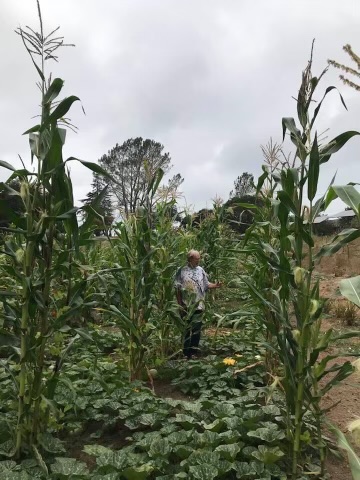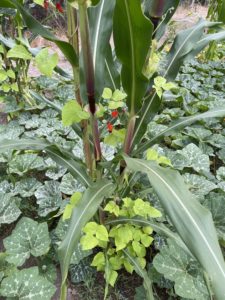Gobble, Gobble!

The only turkey bird native to California, Meleagris californica, went extinct 10,000 years ago. The wild turkeys that presently…
choose your own verb to insert into this sentence from the following list:
a. plague
b. ornament
c. desecrate
d. populate
e. despoil
f. violate
g. enrich
….California, are not from here at all. Heck, they are not even from Turkey! Turkeys were domesticated from the native wild flocks thousands of years ago by the indigenous peoples of what is today Mexico. Following the conquest of Mexico by the Spanish the domestic turkey made its way to Asia, then down the Silk Road to Europe. These birds probably earned theirEnglish misnomer because they were first imported to the British Isles from ports in the Eastern Mediterranean controlled by the Ottoman Turks. And while the continuous and wide ranging domestication of the turkey led to the development of various farmyard breeds, the wild turkeys that are their proper ancestors never stopped running riot in the forests—- except in California, where over-hunting of the native birds by the native people is likely what made extinct a species we now only know through the fossil record.
 Mother Nature has a refined sense of irony. When I decided to plant a milpa this spring I was looking forward to trying out a planting style that was developed in ancient Mexico. In a milpa, a holy trinity of corn, squash, and beans are cultivated together in harmony. The corn grows upright and its thick stocks serve as a ladder for the beans to climb up and find support in. Meanwhile, the squash plants spread out across the ground and choke out any weeds. Even the weeds common in the milpa that do poke through the canopy of squash, like the wild tomatillos, lambsquarters or purslane, are edible and are appreciated for the variety they add to the diet.
Mother Nature has a refined sense of irony. When I decided to plant a milpa this spring I was looking forward to trying out a planting style that was developed in ancient Mexico. In a milpa, a holy trinity of corn, squash, and beans are cultivated together in harmony. The corn grows upright and its thick stocks serve as a ladder for the beans to climb up and find support in. Meanwhile, the squash plants spread out across the ground and choke out any weeds. Even the weeds common in the milpa that do poke through the canopy of squash, like the wild tomatillos, lambsquarters or purslane, are edible and are appreciated for the variety they add to the diet.
In my milpa I chose to plant a Oaxacan corn, a Japanese runner bean and a French squash. All of these crops had, of course, been essentially developed in Mesoamerica before the “Columbian Exchange” but had then found a new
refinement after being cultivated overseas in different countries. I figured that my multi-cultural milpa would be a fun expression of California’s culinary and human diversity. And I haven’t been disappointed. The French Doran squash have scrambled across the ground and cloaked the soil, choking out weeds. The Japanese Akahana mame beans have twined their way up the stalks of Oaxacan Pinto corn, which reach 10 feet high into the sky. I even planted some sunflowers to brighten the corn patch. Sunflowers are yet another invention of pre-Columbian American farmers. But I wasn’t counting on the turkeys.
In Mexico the word for turkey is “guajolote” and there is no food more essentially Mexican than Mole Poblano, or guajolote served in a mole sauce. And mole sauces typically are made rich and velvety with squash seeds that have been pounded into a paste. The people that invented the milpa, that developed the corn, squash, and beans from wild plants into major crops—these people really knew how to live at home in their environment. Not only did they create a number of the world’s most important food crops, they also knew how to eat the pests that plagued those crops. The corn fungus that disfigured the young ears of corn was considered a delicacy- huitlacoche- and when it presented itself in a crop it was welcomed, not treated with fungicide. The grasshoppers that would eat the young corn were gathered to be cooked up to be served alongside the beans and squash. In an elegant twist of fate the corn earworms that eat young corn and leave a disfiguring pathway through the neat rows of colored kernels were themselves cooked in hot oil and served to hungry diners in corn tortillas. And the wild turkeys that dared to invade the milpa were tamed and domesticated. The ancient farmers that created the milpa system of farming were thrifty and creative. Then there’s me….
The packs of wild turkeys that roam my yard haven’t ruined my milpa but they have made success more of a challenge to achieve. These big, fat birds have pecked some of the squash, devoured the sunflowers, and torn up a lot of the beans by thrashing around in the corn patch taking dust baths. I could solve the problem by shooting the turkeys and serving them in a corn tortilla with a tomatillo de milpa salsa. But I won’t. As much as the turkeys annoy me by stealing cat food from my kitty’s bowls, by crapping all over my yard, and by messing up my garden, I do find them entertaining and puzzling. How can wild turkeys be so stupid and still survive? Everyday they come to the fence as they cross the property and walk back and forth in confusion, forgetting that they know how to fly and in fact have flown over the same fence many times before, even earlier that same morning.
So the turkeys walk back and forth along our fence line dressed in stupid splendor, their plumage flashing their psychedelic, iridescent camouflage that so curiously is flashy yet effective at blending them into the grass. Once the turkeys finally do hop across the fence with a simple flap of the wings they line up at the top of our little slope just south of our house. They like to run down the hill that has become their personal runway to help them with their takeoff, and they make a great, noisy beating of their wings before they catch flight. Overhead the turkeys look like pterodactyls as they fly across the sky, heading to the tops of the tall Torrey pine tree at the foot of the hill. Each turkey selects its own tree limb to land on. After some squawking and gobbling and fluffing of feathers they settle down to sleep. The ground below their roosting tree is littered with turkey crap- and with coyote turds because our sharp-nosed canine companions are always hoping for a turkey dinner.
—© 2021 Essay by Andy Griffin. Photos by Starr Linden


